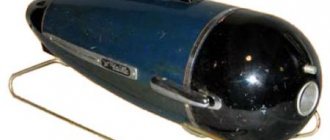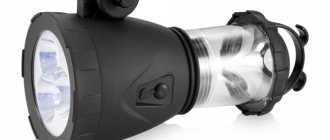Good health to everyone! Today, most cars are equipped with both a standard security system and a third-party system. In my case, the security system was installed from the manufacturer. Such systems have relatively limited functionality: immobilizer, central locking, sound alarm (from door switches). Third-party manufacturers offer wider functionality, such as autostart, feedback and much more. Personally, I don’t have any particular need for such functionality, despite all its advantages. But the standard security system does not have an LED - a beacon, which is an indicator, so to speak, of a “cooler” car security system. In most cases, yard hooligans are deterred by the presence of such a system rather than the presence of a standard one, which in most cases signals unauthorized entry into the car only by signals from the door and hood limit switches. In other words, it is possible to “take out the glass” and pull out what is “badly lying”. In more advanced security systems, for example, there are shock sensors, which, when triggered, produce a sound and light alert, for example, to the entire yard. Yes, according to statistics, cars that have a “beacon” are opened less often than cars that do not have one.
Since I don’t want to spend a lot of money on a third-party security system due to the lack of need for the latter, I decided to install a dummy LED beacon. As usual, our “partners” from heaven come to the rescue. As usual, they have a lot of stuff. Dummies of beacons were also available.
It is noteworthy that they are powered by an internal source and solar panels, judging by the description. An autopsy will show whether this is so.
In the meantime, I decided to make such a dummy myself. This required a soldering iron, a pair of transistors, a capacitor, several resistors, a semiconductor diode, a breadboard, and the simplest LED itself, as well as a free evening.
The flash frequency is determined by the value of resistors R1 and R2 and capacitor C1. Resistors R1 and R2 have different effects on the process. The duration of the pause between pulses largely depends on R1, and the duration of the pulse depends on R2.
Below is a table of part ratings for setting the flash frequency and power supply of the circuit.
I selected the required LED flash frequency by changing capacitance C1. Transistors used KT3102 and KT3107.
The board was filled with hot glue and wrapped with electrical tape, since there was no suitable case at hand. The scheme works. Can be installed in a car.
I plan to power the circuit from the central locking so that it can be seen from the window of the house that I did not forget to set the car alarm.
Source
How to make an imitation car alarm using an LED
This happens in the practice of a motorist when there is no alarm in the car, but you need to imitate it in order to scare off dishonest people and other interested people. To make a car alarm simulator, you will need a twelve-volt battery and a circuit assembly using several radio components.
Pay attention to what a flashing red LED looks like in operation, like conventional alarms. It’s not difficult to make - you need a soldering iron, tin solder, rosin. The simulator itself consists of only 4 parts and assembling the circuit is not difficult. The simulator signal consists of an LED, preferably red, to emphasize that it belongs to standard devices. One 5.6 kOhm resistor, one electrolytic capacitor 470 microfarads and one KT transistor, possible with any letter, from the author of the video marked “B”. The circuit is assembled in literally five minutes according to the diagram (below in the photo).
car alarm simulator circuit
So, the circuit is assembled. Now let's check. Look - everything works. Now we will hide this circuit in a box so that it does not get damaged and secure everything inside with hot glue, except for the LED. It is better to install the latter on a long wire so that the box can be hidden, for example, in the glove compartment of a car, and the LED can be attached with adhesive tape to the bottom of the windshield.
The circuit can be powered from a cigarette lighter; such plugs are commercially available. In order not to damage the circuit, it is best to secure it in some box using hot-melt adhesive. After checking, it is best to glue it a little so that it does not open on its own.
There is a switch in the box, so now it can be permanently installed in the car and simply turned on with the switch. Now, finally, the last check before installation on the car.
Let's see how it works on the car now. The camera does not take good pictures at night, but the silhouette of the car and the blinking LED are still slightly visible. Compare what a house looks like, for example, without an alarm system and what a house looks like with it or with a pseudo-alarm system.
There is another useful article on our website about DVRs.
Question. There is no current limitation through the LED in the circuit! With a high-quality capacitor, most LEDs can quickly fail!! The transistor may also fail because of this. To prevent this from happening, a current-limiting resistor is needed. The transistor operates when turned back on in avalanche mode. For KT315 this mode is not standardized. That is, some transistors in this mode may be inoperative or operational only in a limited temperature range. There are many simple circuits, both on a microcircuit and on two transistors, where all components operate as normal. Well, it’s inconvenient to mention blinking LEDs with an already built-in circuit. Sold on every corner. The use of a one-watt resistor and thick wires is surprising. There are no such currents and powers in the circuit. And if there are vibrations in the car, the design can very quickly become inoperable. Fastening parts directly to a non-rigid body under vibration conditions is a design mistake. The parts need to be secured to an intermediate structural element, and this element must be attached to the body. Moreover, it must be fastened in such a way that no forces are transferred to the parts from deformations of the body.
Answer from the author of the homemade product: And as soon as the scheme, with such criticism, can work, I can only say that all these “shortcomings” have been made up out of thin air.
Why do you really need an LED alarm in a car?
When going out on the balcony of my house in winter, the yard of which is absolutely not lit, I was always pleased by the picture - a garland of blinking LED alarms of parked cars.
I am sure that many car owners who have installed an additional alarm system on their car have little idea why they drilled a hole in the plastic of the front pillar at the installation center and installed a blue or maybe a red LED? What can I say, installers don’t always understand the need for an LED, the installer’s manual says “drill and install,” so we do it.
Typical drivers’ ideas about the functionality and purpose of a flashing LED:
First
, scares away thieves, looters and even experienced car thieves, they say, why bother, let's go to the neighboring yard, where there is the same one without an LED.
Of course, this has no connection with reality, the hijackers go to work prepared: creating interference on the 868 frequency is easy, turning off the siren is elementary, finding the blockage of the fuel pump is also a matter of minutes. Marauders also don’t care what color the LED is, but the alarm sometimes saves you from gasoline “sippers.” On 2107 and 2121, I installed an additional limit switch on the gas tank flap, the alarm went off several times at night, and in the morning I saw only an open flap, but again the siren scared them away, not an LED.
Second
, a more plausible and partially correct opinion is an indication of the alarm status. Not blinking means disabled, blinking means enabled, and the pulse frequency can convey additional information. LEDs are even installed from the factory on cars that have central locking or a standard security alarm.
One more point -
indication of mark definition, which is very necessary so as not to have to think again why the engine does not start. Somewhere a separate sound indicator is used for this, somewhere an LED indicator. Modern systems try to use the CAN bus for this and “inform” through standard light bulbs.
However now
, with the introduction into the masses of key fobs with feedback, GSM systems that allow control via an application on the phone, and so on, there is no great benefit from the LED to the end user. The main purpose of the LED is to allow the installer to perform coding and configuration.
Source
Instructions for creating a dummy with a pulsating LED signal with your own hands
It is quite simple to acquire a device that imitates a real alarm system. First you need to disassemble a simple electric alarm clock. After removing the protective casing, access to the electronic board will open. The latter is responsible for generating and redirecting current pulses to the stepper mechanism.
Electronic board responsible for controlling the clock mechanism
Next, armed with a heated soldering iron, you need to assemble the following circuit:
In fact, it is necessary to connect the LED and an additional battery. The latter should be similar to the element that powers the clock. It is permissible to connect two batteries into one by soldering metal jumpers to them. A cassette from an unnecessary flashlight can also be used, in which it is convenient to place several power elements.
A cassette designed to combine AA batteries into one unit
After connecting the batteries, the LED will light up and go out twice per second. Extending the life of the “device” is facilitated by its placement in a sealed container. You can use a liter glass jar with a lid for these purposes. The latter is recommended to be installed at chest level. It is advisable to make sure that the flashing light signal is clearly visible through the fabric of the curtains covering the windows.
The presence of a failed camera implies the possibility of installing the mechanism in the inside of the case. The LED is located in the place designated for this purpose. Cameras converted in this way are usually placed on the ceiling (in line with the front door). Mounting on the outside of the wall is also permissible.
Service life of the security system simulator
The period of operation of the dummy is determined by the quality of the power source. AA batteries can work non-stop for 6-9 months. It is also important to consider that white LEDs are more power-hungry, while purple LEDs consume less current.
It is advisable to equip simulators mounted outdoors with frost-resistant batteries. The higher cost is justified by the reduced likelihood of damage to the power element during the first significant cold snap.
Source
Lada 2113 Black metallic › Logbook › Changing the LED alarm status indicator
Continuing the epic with changing the backlight, I decided to change this terrible red alarm blinker. And in general, this idea arose in me much earlier than the desire to redo the backlighting of the buttons, because when passing foreign cars, I often noticed the pleasant blue blinking of the alarm indicator and already at that moment I decided that I needed to do this.
Well, okay, let's get down to business as they say.
Since I had to remove the middle part of the panel, I had to cut the indicator wire, because otherwise it was impossible to pull it out. I took the LED to work to find out its characteristics. Initially I thought it was 12 volt. But let’s remember the rule from the previous post that you initially need to set the minimum voltage on the power source and then do the experiment. In general, I set it to 3 volts, turned it on, and through the LED there was already a current of about 50 mA, this is some kind of ahtung) I increased it to 3.4 V, the current became equal to 80 mA. This is very bad for an LED! It turns out that I thought wrong, this LED was approximately 2.4 V. I didn’t bother racking my brains and dancing with a tambourine, but found the official website of the manufacturer of my alarm on the Internet and called technical services. support and found out which LED to replace the original one with. They replied that set any to 3 V, and the resistor is inside the alarm unit, so there is no need to worry.
Well, that's exactly what I did. I bought Vol from the same place, the price per piece is 7 rubles.
Next comes the process of minor modernization.
We take the LED and check the polarity. We take a two-core wire, tin the ends and solder it to the LED:
We take male terminals, solder them, crimp them, and blow in heat shrink. I specifically take terminals of different sizes, smaller ones for “-“, larger ones for “+”, so that there are never any problems with determining the polarity











